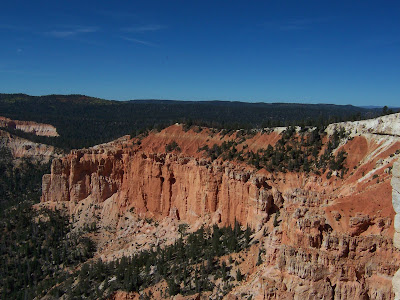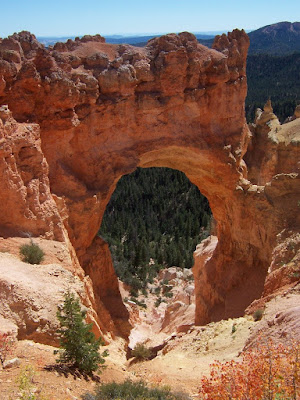 .... We made it to Bryce and the temps (60's) are just perfect for sightseeing and hiking. This national park is famous for its hoodoos. What's a hoodoo? Well the park brochures say... Hoodoo - a pillar of rock, usually of fantastic shape, left by erosion. Hoodoo - to cast a spell. At Bryce Canyon National park erosion forms an array of fantastic shapes we know as hoodoos. Surrounded by the beauty of southern Utah, hoodoos cast their spell on all who visit. Geologists say that 10 million years ago forces within the Earth created and then moved the massive blocks we know as the Table Cliffs and Paunsaugunt plateaus. Rock layers on the Table Cliffs now tower 2,000 feet above their corresponding layers on the Paunsaugunt. Ancient rivers carved the tops and exposed the edges of these blocks, removing some layers and sculpting formations in others.
.... We made it to Bryce and the temps (60's) are just perfect for sightseeing and hiking. This national park is famous for its hoodoos. What's a hoodoo? Well the park brochures say... Hoodoo - a pillar of rock, usually of fantastic shape, left by erosion. Hoodoo - to cast a spell. At Bryce Canyon National park erosion forms an array of fantastic shapes we know as hoodoos. Surrounded by the beauty of southern Utah, hoodoos cast their spell on all who visit. Geologists say that 10 million years ago forces within the Earth created and then moved the massive blocks we know as the Table Cliffs and Paunsaugunt plateaus. Rock layers on the Table Cliffs now tower 2,000 feet above their corresponding layers on the Paunsaugunt. Ancient rivers carved the tops and exposed the edges of these blocks, removing some layers and sculpting formations in others. ...We drove down to the southernmost point of the scenic road to began our tour. The following four photos show the view from Rainbow Point. Elevation here is over 9,000'.
...We drove down to the southernmost point of the scenic road to began our tour. The following four photos show the view from Rainbow Point. Elevation here is over 9,000'.Now back to the park brochure... Paiutes, who lived in this region when settlers and other people from the eastern states came to southern Utah, accounted for the hoodoos as the "Legend People" whom Coyote had turned to stone. Capt. Clarence E. Dutton and John Wesley Powell explored this area in the 1870s and gave it many place names. Dutton's report gave the name Pink Cliffs to the Claron Formation. Names from the Paiute are Paunsaugunt, place or home of the beavers; Paria, muddy water or elk water; Panquitch, water or fish; and Yovimpa, Point of Pines. Clarification from me... The Claron Formation is the sedimentation layer that the hoodoos are eroded from. Paria is the name of the river that carved the plateau edges. Panquitch is the name of a nearby town. Yavimpa is the name of one of the viewpoints.
Back to the brochure.... Paiutes were displaced by emissaries of the Church of Jesus Christ of Latter-day Saints who developed many small communities in Utah. Ebenezer Bryce did such work in southwestern Utah and northern Arizona. In 1875 Bryce came to the Paria Valley to live and harvest plateau timber. Neighbors called the canyon behind his home Bryce's Canyon. Soon after 1900, people were coming to see the colorful geologic sights, and the first accommodations were built along the Paunsaugunt Plateau rim above Bryce's Canyon. By 1920 people were trying to protect the canyon's scenic wonders. In 1923 President Warren G. Harding proclaimed part of the area as Bryce Canyon National Monument under the Powell (now the Dixie) National Forest. In 1924 legislation was passed to establish the area as Utah National Park, but the provisions of the legislation were not met until 1928. Legislatioin passed that year changed the name of the new park to Bryce Canyon National Park.

Back to the brochure.... Paiutes were displaced by emissaries of the Church of Jesus Christ of Latter-day Saints who developed many small communities in Utah. Ebenezer Bryce did such work in southwestern Utah and northern Arizona. In 1875 Bryce came to the Paria Valley to live and harvest plateau timber. Neighbors called the canyon behind his home Bryce's Canyon. Soon after 1900, people were coming to see the colorful geologic sights, and the first accommodations were built along the Paunsaugunt Plateau rim above Bryce's Canyon. By 1920 people were trying to protect the canyon's scenic wonders. In 1923 President Warren G. Harding proclaimed part of the area as Bryce Canyon National Monument under the Powell (now the Dixie) National Forest. In 1924 legislation was passed to establish the area as Utah National Park, but the provisions of the legislation were not met until 1928. Legislatioin passed that year changed the name of the new park to Bryce Canyon National Park.

...On the horizon is the formation known as the Aquarius Plateau. You'll be seeing it in a lot of the photos of Bryce Canyon.


From Rainbow Point, we hiked the Bristlecone Loop Trail and walked to Yovimpa Point.

View along the Bristlecone Loop trail



 ....We walked up to Yovimpa Point. On the far horizon you can just make out Navajo Mountain, 82 miles away. From the display at the point... This sacred mountain of the Navajos lies on the Utah/Arizona border.
....We walked up to Yovimpa Point. On the far horizon you can just make out Navajo Mountain, 82 miles away. From the display at the point... This sacred mountain of the Navajos lies on the Utah/Arizona border.
Just about at the horizon in the mid-left (just above where the red cliff ends) you will see Molly's Nipple which is 25 miles away. The point's display says it isn't a volcano.

...At the horizon, the Kaibab Plateau is 80 miles away. This is the Plateau from which the Colorado River carved the Grand Canyon.



...We got back in the car and started heading north and stopping at viewpoints.

This is what we saw as we walked up to the viewpoint. The guard rail is wood.


...It's hard to see in this photo, but there is a hole in this "fin".

 View from Ponderosa Canyon viewpoint.
View from Ponderosa Canyon viewpoint.

Just a photo of the road going through the park.




...Ok, if you look real, real close...enlarge the photo by double clicking it... you can see a white hoodoo on a red pedestal just left of center.
 Closeup of some of the formations show fantastic shapes like this turreted fin.
Closeup of some of the formations show fantastic shapes like this turreted fin. ...At the next viewpoint I had to take a photo of the manzanita. A display at the Visitors Center says that... Greenleaf manzanita, with its round evergreen leaves and smooth red bark has always been a favorite of wildlife - bears particularly like its dark berries. Native Americans ground the berries into a meal, or ate them raw. They also used the berries for medicinal purposes. Anyway you could see manzanita growing all over the place.
...At the next viewpoint I had to take a photo of the manzanita. A display at the Visitors Center says that... Greenleaf manzanita, with its round evergreen leaves and smooth red bark has always been a favorite of wildlife - bears particularly like its dark berries. Native Americans ground the berries into a meal, or ate them raw. They also used the berries for medicinal purposes. Anyway you could see manzanita growing all over the place.







No comments:
Post a Comment